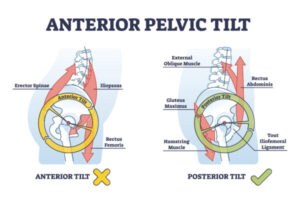
It’s when the trunk is in a neutral position while the pelvis rotates forward or anterior
pelvic tilt over the hips in a short arc. The curvature of the low back and the buttocks will
appear more pronounced in an individual with a slanted pelvis when viewed from the
side. An anterior tilt of the pelvis can be misdiagnosed as a result of bad posture, but a
medical evaluation is still necessary to evaluate the degree of the slant and rule out
muscular disparities that may impede movement. If you are experiencing discomfort due
to this type of posture and you require medical attention, seek help from Pain
Management Doctors or you can proceed to the Pain Medical Clinic.
Tilting the pelvis forward leads to pain
An anterior pelvic tilt is frequently associated with a muscular imbalance. It has the
potential to be an APT indicator or perhaps a contributor. This could be some of the many
other probable causes of
● Sedentary lifestyle
● Overly taut hip flexors (iliopsoas muscles)
● Genetics
● Not getting enough exercise
In particular, hyperlordosis is often characterized by shortened, tight iliopsoas muscles.
And common factors like sitting for lengthy periods of time at work or in transit, engaging
in strenuous physical activity like playing sports, or even overstretching can all contribute
to their development.
Your iliopsoas muscles will get tight from being overused or constricted by staying in one
posture for too long due to your regular activities. These already-weak muscles will
tighten further as they are forced to do extra work to keep your hips and abs from
wobbling.
In addition to creating discomfort, muscle cramps, and a forward pelvic tilt, tightness
places unnatural stress on the pelvic bone, leading to even more tightness and strain.
Although the pelvic bone is being dragged forward, the hamstrings are being lengthened
and weakened. That leads to an even greater mismatch in muscle development.
Signs of a forward-leaning pelvis
A protruding abdomen and an accentuated lumbar spine curve are the two most
noticeable symptoms or indicators of an anterior pelvic tilt. Sometimes the waistband of
a pair of pants or shorts will be angled downward, creating a diagonal line with the floor.
Additional signs of a pelvic tilt in the front include:
● A preponderance of weakness in the low back and quadriceps muscles.
● Dismal strength in the core
● Hip flexor or iliopsoas muscle stiffness or tightness
● Having trouble getting your glutes to work
If left untreated, anterior pelvic tilt might worsen over time. When the pelvic tilt gets bad
enough, it might hinder exercises like squatting and deadlifting. It also increases the risk
of knee and low back injuries. Despite the apparent simplicity of these symptoms, a
thorough medical evaluation is always necessary for the diagnosis and treatment of APT.
Doral Health & Wellness’ Pain Medical Clinic offers effective treatment for upper back
discomfort, shoulder pain, and backaches brought on by anterior pelvic tilt and it also
improves a healthy lifestyle. The clinic is accessible via bus, train, and skyway. Brooklyn,
New York 11212, at 1797 Pitkin Avenue. To schedule an appointment or learn more, call
347-868-1016 or check out http://www.painmanagement.scrolluptech.com/.
